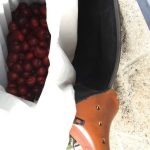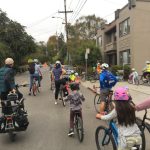![]()
(full video below)
If you ride a bike or walk on our nation's roads, you've probably encountered beg buttons at some point. They are buttons that you have to push to get a walk or bike signal at an intersection. They are supposed to make traffic flow more smoothly.. for cars. They do the opposite for people who are not driving, and clearly indicate the hierarchy of your city's transportation priorities.
A few weeks ago, I was riding towards home near North Berkeley BART. There's been a considerable change to the bike infrastructure here, but the end result (or current result?) is something that is not usable. Here, I waited through a light cycle for a green light to continue across the road and onto the bike path, but I never received a green signal. I read the sign: "To Request Green wait on (bicycle)" and then looked around for a bicycle stenciled into the asphalt to wait on. I couldn't find one. I wasn't sure if there was a sensor that was supposed to be in the asphalt or a HAWK beacon camera that was set up to detect me in a certain location. I saw that there was a pedestrian beg button on the sidewalk, but I was carrying too much stuff on my bike to be able to roll up onto the sidewalk and press the button. And my bike wasn't stable enough to leave unattended on the street to walk up and press the button. This is bad from an accessibility standpoint.
And I also wondered, why do I even need to push a button? If I were driving a car, I'd eventually get a green light automatically. No need to press a button, look for a sensor, be detected by a video camera with questionable algorithms, or get out and do something else. It's automatic for drivers.
Beg buttons are unfair to people who bike and walk:
- They make you wait longer. And even after you wait, you might not even be given "permission" to cross the street. Even if the light is green for cars, you may have to wait for another cycle after you get a signal to cross.
- The buttons can be hard to access and use. In this case, the beg button was located far from the bike lane, which would have forced me to ride onto the curb, lean over to press a button, then straighten out my bike and trailer while trying to keep it upright. This might not seem like a huge deal, but I'm just trying to cross the street, and if I were driving, I wouldn't have to do any of this.
- Overall, these beg buttons send a message that clearly outlines the priority that the roads and intersections were designed for. By having to beg for a signal, the implication is that my mode of transportation was less important to Berkeley City planners than driving. (I should add that there are some good bike infrastructure examples in Berkeley, but they are sadly not common, and the bar is low)
In this case, I would have preferred to just have an automatic walk/bike signal. It takes extra work to add buttons, etc to to the sidewalks. The beg buttons in general feel like examples of the city going out of their way to make things more difficult for people who walk and bike, sacrificing their time and safety for those who drive vehicles that pollute and are responsible for 40,000 deaths per year in the USA.
Even better would have been a protected intersection, where there are more physical barriers (curbs, planters, bollards) between the bike lane and the car lane and corner islands to shorten the crossing distance.
I'm hoping that the intersection was just not complete and that there was recent construction (...) and that this will be fixed soon.




